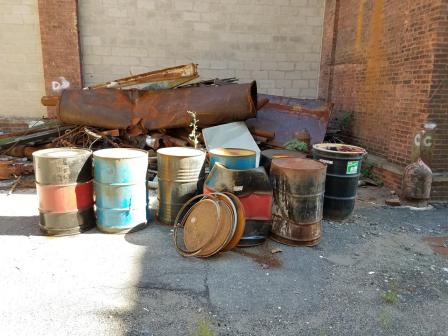EPA Researchers Provide Data and Information to Cleanup a Mercury Contaminated Site
Published June 22, 2020
 Drums at the Vo-Toys site.In Harrison, New Jersey, an industrial complex known as the Vo-Toys site spans a city block. The complex was used to manufacture incandescent lightbulbs from 1902–1918, radio vacuum tubes from 1918–1976, and pet products from 1977-2014. In 2015, developers wanted to redevelop the site for residential use. Three of the buildings were found to be contaminated with elevated levels of mercury, including beads of mercury on building materials and mercury-contamination in the soil, and were subsequently left abandoned.
Drums at the Vo-Toys site.In Harrison, New Jersey, an industrial complex known as the Vo-Toys site spans a city block. The complex was used to manufacture incandescent lightbulbs from 1902–1918, radio vacuum tubes from 1918–1976, and pet products from 1977-2014. In 2015, developers wanted to redevelop the site for residential use. Three of the buildings were found to be contaminated with elevated levels of mercury, including beads of mercury on building materials and mercury-contamination in the soil, and were subsequently left abandoned.
Mercury is a naturally occurring chemical element found in rock in the earth's crust. It historically has had many industrial uses including in lighting, thermometers, and gauges. It is also a neurotoxin, which can cause adverse health effects, including harm to the brain, nervous, and immune system.
Mercury becomes a problem for human health and the environment when it is released and ends up in the atmosphere, soil, and/or water. While these releases can happen naturally, such as from volcanoes or forest fires, human activities such as improper disposal of certain manufacturing wastes and consumer products can also be responsible for mercury that is released into the environment.
The New Jersey Department of Environmental Protection (NJDEP) is the lead for investigating and cleaning up the Vo-Toys site, but asked EPA to evaluate the site for potential risks to the community and determine safe ways to remove the contamination, which a particular focus on potential fires at this location.
For this evaluation, EPA Region 2 worked with EPA scientists in the Site Characterization and Monitoring Technical Support Center (SCMTSC) and the Engineering Technical Support Center to determine what risk the facility posed to the community, especially in the case of a fire. Researchers worked with the Region to collect data about the amount of mercury at the site, as well as other materials that could impact a fire. They then used this data to create models of different fire scenarios.
“It became clear that it wouldn’t take a lot of mercury to be a potential health concern during a combustion event, and there was certainly enough remaining in the buildings to be a problem,” said SCMTSC Director Felicia Barnett.
As a result of the modeling work done by EPA researchers, EPA Region 2 was able to provide education to first responders about environmental and health dangers the site may pose in the case of a fire. They also trained first responders in how to best protect themselves from these risks and helped create an evacuation plan for the surrounding community in the case of a fire.
“We identified the most accurate model estimate available based on the site data and performed the modeling to support Region 2 in protecting their community,” said Barnett.
The modeling also proved the extent of risk that the site posed to the community and paved the way to removal. Currently, one of the buildings is being demolished and workers are responsibly disposing of building materials. EPA researchers continue to assist Region 2 in their removal efforts.
Learn More
Health Effects of Exposure to Mercury
Site Characterization and Monitoring Technical Support Center
